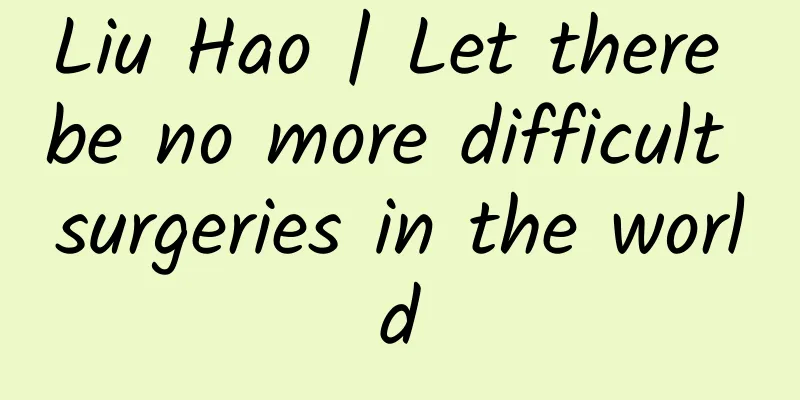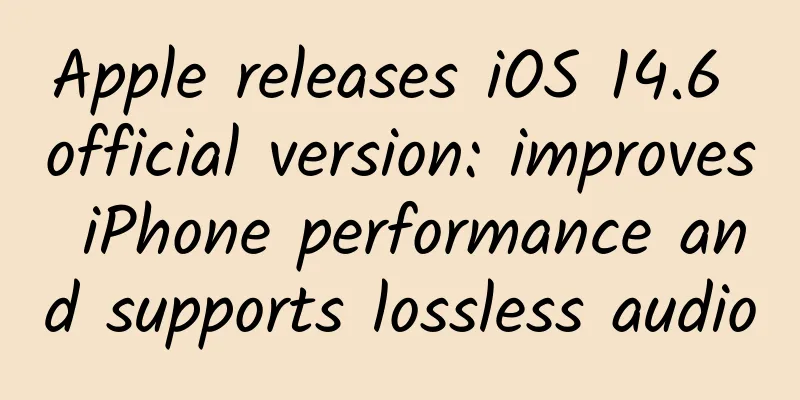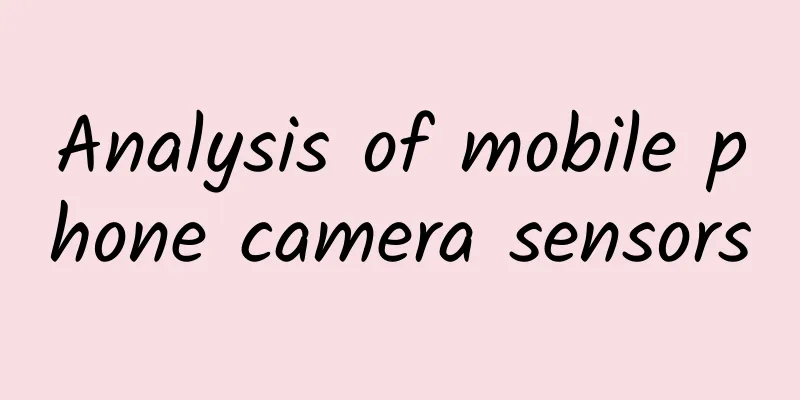Liu Hao | Let there be no more difficult surgeries in the world

|
"Robots have largely liberated people's brains, freeing them from technical operations and disease identification, allowing them to focus more on how to treat diseases." Liu Hao Shenyang Institute of Automation, Chinese Academy of Sciences For the past 15 years, I have been pursuing one thing, which is to make surgery easier to perform in the world. It stands to reason that this is something a doctor should pursue. In fact, what I do is closely related to doctors. I have always respected doctors since I was a child. I was born with severe anemia. It can be said that my life was given by my mother, but it was saved by doctors. I believe that many people may have similar experiences. Around 1997, when I was in high school, there was a very popular TV series called "Red Cross Parade", which told the growth experiences of military doctors. It touched me deeply, and I wanted to apply for the Fourth Military Medical University at that time. What’s a pity is that I missed the physical examination and did not become a doctor. I think this might have been a change in the trajectory of my life. But coincidentally, when I was a junior at Harbin Institute of Technology, my mentor, Professor Wang Shuguo, introduced me to surgical robots. From that time on, I began to get more exposed to the profession of doctors, especially some surgeons who perform operations. What does surgery look like in people's minds? We may have some basic understandings. From the patient's perspective, we can easily understand that surgery should be very painful, but it is actually difficult for us to understand what kind of psychology the doctor's inner world is like. After we had more contact with doctors, we found that this profession actually requires us to endure tremendous psychological pressure. When performing surgery, the doctor needs to concentrate highly and he must be very nervous. Even at the end of the operation, he was very devastated. Because this operation (pancreaticoduodenectomy) is really difficult to perform, especially some surgical operations, a tiny mistake may cause vascular bleeding, then heavy bleeding may endanger the patient's life at any time. In such a context, doctors bear a responsibility for people's life and health. Pancreaticoduodenectomy This is a very famous operation, which can be said to be a pinnacle operation in general surgery. As can be seen from the video, the blood vessels need to be severed layer by layer, some tissues need to be cut off, and then the severed blood vessels need to be anastomosed. This operation involves 4 organs, more than 30 instruments will be used alternately, and the operation time is 8-10 hours. When I first heard the doctor introduce this surgery to me, I was really shocked. I actually had another thought in my mind, that I was lucky not to become a doctor, because doing such a surgery is really very complicated and beyond my imagination. Later, as I gradually came into contact with more complex surgeries, I wondered whether surgical robots could solve these problems. Fortunately, surgical robot technology has been developed to a great extent, and many surgical robots can be used in clinical practice. Imaginary surgical robots In fact, when I first came into contact with the field of surgical robots, this was the impression I had about surgical robots. But in fact, up to now, surgical robots are affected by various factors such as the location of the surgery and the operation, and there are many kinds of them. So far, there are various surgical robots in clinical use or in research, from hair to toes. There are also significant differences in the types of these surgical robots. For example, the surgical robot for abdominal surgery uses a very thin endoscope to be inserted into the abdomen, and then uses surgical forceps and scissors to perform soft tissue surgery. Orthopedic robots use tools such as drills and grinders to manipulate hard tissues such as bones. There are many types of these surgical robots, each of which plays its own role. What will they bring to us? We can imagine it intuitively. We can easily compare surgical robots with humans. Surgical robots have hands and eyes. For example, the hands of surgical robots do not shake. A few years ago, if you wanted to be a surgeon, but your hands had some uncontrollable shaking, although not as severe as that of Parkinson's patients, you would not be eligible for this career. For example, surgical robots can reduce human manual operations many times, and can do very precise sutures on blood vessels as small as two or three millimeters. In addition, surgical robots will not get tired or go on strike, and they can maintain very stable surgical operations for a long time. These are the very basic benefits that surgical robots can bring to us. But we may be more concerned about what surgical robots can do for patients and doctors on the operating table. Let's use these three short stories to introduce what surgical robots can do for us. Completed: 30% ////////// Putting "hands" into the abdominal cavity for delicate operations The first story is that a few years ago, I visited Professor Zhang Zhongtao, a very famous surgical expert at Beijing Friendship Hospital, and he told me about the development process of surgery. Escalation of abdominal surgery In the early days, doctors directly opened the patient's chest and abdomen and performed surgery in an open environment. This type of surgery was actually quite simple. Although this method achieves the effect of surgery, it does not pay attention to the patient's quality of life and will leave very long scars on the patient's body. In the 1980s, laparoscopic surgery emerged. It involves making a small hole four to five fingers thick in the human abdominal cavity, and then placing a slender endoscope and surgical instruments into the human abdominal cavity to perform minimally invasive surgery. After the operation, the patient will have four or five small scars on his body. With the latest technology, we put all the surgical instruments into the abdominal cavity through a window, and after the operation, we found that there was no scar. In fact, we used the natural scar of the belly button. Some young women think their belly buttons are not beautiful, so they may have cosmetic surgery on their belly buttons so that they can wear belly-revealing clothes. With this new technology, we can do a surgery and treat it as a cosmetic surgery for your belly button. During this process, the scars become less and less, which is a perfect result for the patient. But for the doctor, it is completely the opposite, and the difficulty of his surgery has increased to a very high level. This is a scene of a single-port surgery. Imagine that when we put many instruments and endoscopes into the abdominal cavity through one hole, the operation of these instruments will inevitably conflict. During surgery, when the doctor operates the forceps, his external movement and the movement of the forceps are exactly opposite, and the surgical instrument itself is very inflexible, which can cause conflicts between the surgical instruments, making the doctor's surgery take a very long time. We need a surgical robot with a range of hands. We thought of many solutions and made many attempts, and finally we thought of borrowing from a creature in nature. It is a delicacy, and there is a street in Beijing that specializes in this delicacy, which is crayfish. The shape of the crayfish is very good because its eyes and two hands form a very professional term in surgery called the surgical triangle. When people perform surgery, they also open their hands and look with their eyes. Only with such a triangular relationship can the surgery be done well. Our instruments are derived from the characteristics of this creature. Structurally, they are very similar, with two hands and eyes. Moreover, the hands and eyes can deform and move very flexibly and freely, which meets our surgical requirements. First of all, its degrees of freedom are sufficient, with 6 to 7 degrees of flexible deformation, which has actually reached the dexterity of human arms, and its operating accuracy can reach the millimeter level, which meets the requirements of doctors for performing delicate surgery. We just restored the human surgical operation in its movements. In fact, there is another problem with surgical robots. We lost the sense of force when we used to cut tissue with a scalpel, so we developed a small sensor and integrated it at the front end of the surgical instrument, with an accuracy of millinewton level. This is far beyond the resolution that human hands can feel. We have also developed human-computer interaction equipment that allows people to experience this sense of force when operating. In this way, we have restored both human hand movement and force perception. This is a video of our force experiment. We can see the operating forces in all directions and can collect them all. Of course, we also made some very interesting videos. This is an experiment of suturing grape skins. The operation is very delicate. The grape skins are very thin and the flesh is very soft. After we sewed them, the grapes were still intact. This video is even more interesting. This is the idea of one of my doctoral students. He thought that since this surgical instrument is derived from a creature like crayfish, let's have a fight. This surgical instrument gave the crayfish a hug and a throw. The crayfish may be very upset. Although the research process is very hard and boring, there are actually many interesting things. If you want to do this research, this is also a good proof that we can actually experience some fun in the research process. Of course, we will try it on animals before actual clinical use. This is a picture of the first animal experiment. The doctor deliberately tried to use the operating handle during the operation, and it really felt that this operation was very dexterous, which solved the problem of equipment conflict mentioned earlier. From the above story, we get the inspiration that robots are the extension of human hands, which is equivalent to putting human hands in the abdominal cavity to perform very delicate operations. Even with such dexterous operations, it is still not enough. Completed: 50% ////////// “See” the lesion area The second story is that a few years ago, I went to watch a robot perform an operation. The patient had a lung nodule, and before the operation, the doctor used some dye to mark a circle around the nodule on the patient's body. However, these marks were lost during the operation. In the end, the doctor finally found the marks with great difficulty based on his rich experience. This reflects a problem: even if your hands are very dexterous, if your eyes cannot see the lesions below the surface of the tissue, you still cannot perform the surgery well and the surgery will still be difficult. The difference between the human body in books and in the human eye The left side is what you can see in textbooks, where human tissues and organs are clearly separated, and blood has color. The right side is what doctors see, where all tissues and organs are piled together, and it is impossible to distinguish blood vessels and lesions. With the advancement of technology, there have also been some breakthroughs in surgical robots. For example, in the picture, a staining method is used to collect images through fluorescent imaging, so that the surgical robot can see where the lesion is. This is a video of the tumor being removed. During the operation, we can see clearly where the surgery is needed. Of course, there is another technology, which is augmented reality. We can diagnose some lesions through CT and ultrasound before surgery, present them in three dimensions, and find these lesions on the three-dimensional image, including some blood vessels, and then superimpose them on our surgical process. It allows the robot to know where to perform surgery and where not to perform surgery, and avoid some functional and high-risk areas such as blood vessels and nerves. Robotic technology is an extension of the human eye. With the improvement of hands and eyes, we will naturally think about the improvement of robots' intelligence and IQ. Completed: 70% ////////// "Liberating" the brain for doctors Endoscopic examination The third story is about endoscopic examination. Endoscopic examination mainly involves inserting a mirror into the human cavity to see if there are early cancers or polyps, so that early diagnosis and treatment can be achieved. Imagine if a tube is inserted into your body, it would be quite painful. This is a picture of a patient undergoing endoscopic intervention. Actually, the person lying there is me. I am very healthy and have no problems with my digestive tract. We do this because we have a partnership with the General Hospital of the People's Liberation Army of China. Doctors wanted us to make a surgical robot to replace or assist them in diagnosis and treatment. I overcame my fear and dedicated myself to scientific research in order to make this robot. I was nervous at times and wanted to back out, but I persisted. Later, when communicating with the doctor, he told us that, in fact, during the endoscopic intervention process, the doctor's operation needs to go through a tortuous cavity, and his brain also has to think about how to operate in order to avoid excessive traction on the tissue. At the same time, he also has to pay attention to various diseases with different forms like those shown in these pictures, so his brain is occupied to a large extent. With this analysis, we did some research. On the one hand, we hope to make a surgical robot that can make the operation as easy and simple as playing a game. On the other hand, we hope to add artificial intelligence methods to the process of endoscopic acquisition, so that it can autonomously identify which are the lesions and give doctors some prompts. This will reduce the difficulty of the doctor's operation and make it easier for him. This was in December 2017. We performed digestive endoscopy in the human body for the first time. It was very easy for the doctors, who performed endoscopic intervention as if it was a game. During the intervention, we were actually constantly collecting the size of the force of the intervention between the endoscope and human tissue to maintain the safety of the operation. With these technologies, we naturally think about whether we can let robots do this themselves. The video shows one of our attempts, which was very successful. The robot can move from the human mouth to the duodenum by itself, relying on images, force perception and movement. Of course, this was done in a model. Through this example, what I want to convey is that robots have liberated the human brain to a large extent, freeing up his energy from technical operations and disease identification, allowing him to focus more on how to treat diseases. These are the three aspects I want to convey: robots are an extension of human hands, an expansion of eyes, and a liberation of the brain. The problem is that many of my doctor friends strongly condemned me, saying that I was destroying their jobs. In fact, I felt quite wronged. If we look closely, what we want to do is to make sure that there are no more difficult surgeries in the world, not that there are no more doctors. Because the disease still needs to be treated by doctors, surgical robots are just a good auxiliary tool for doctors. With the advancement of technology, some of the more difficult surgeries we face can be performed. For example, the difficulty in space and time, such as the first aid of soldiers guarding the island, their operations can be extended to the scene with robot technology, and the operation can be completed accurately in the first time. This will also bring some good and significant help to our health. Doctors are always standing at the front desk, racing against time to save lives and health. They are not alone on this road, we are with them too, because protecting human life and health is what we yearn for and love, and it is our common mission. The articles and speeches only represent the author’s views and do not represent the position of the Gezhi Lundao Forum. "Gezhi Lundao", formerly known as "SELF Gezhi Lundao", is a scientific culture forum launched by the Chinese Academy of Sciences, co-sponsored by the Computer Network Information Center of the Chinese Academy of Sciences and the Bureau of Science Communication of the Chinese Academy of Sciences, and hosted by China Science Popularization Expo. It is committed to the cross-border dissemination of extraordinary ideas, aiming to explore the development of science and technology, education, life and the future in the spirit of "Gewu Zhizhi". |
<<: Canada geese: They really exist, they caused a disaster, and they were cleaned up
Recommend
Mr. San's "Oral Copywriting Methodology" Advanced Topic Selection - Hot Copywriting, Improve the 5-second broadcast and quickly write hot copywriting
Training course video content introduction: Easil...
Niu Ge Practical Training Camp No. 9
Resource introduction for the 9th session of Niu G...
Is Gionee even more capable of playing monkeys than Lei Jun? How did domestic brands turn full-screen mobile phones into instant noodles?
You know, there is a kind of food you can buy in ...
How to do QQ marketing?
Groups are an Internet product with a relatively ...
Apple executives: We will not consider supporting multiple users for Face ID in the short term
Apple's current Face ID only supports a singl...
Look at the Olympics scientifically: Do you know these 9 little-known facts about the Olympics?
At the 33rd Summer Olympic Games held in Paris, F...
A weather pattern shared by “Fog-locked Beijing”, “Sauna days” and “Pollen allergies”: Why is the weather so stuffy in autumn?
The recent fog in Beijing can be said to be one o...
Where can I find materials for information flow delivery? I will share all my private channels with you!
As the saying goes, if you want to do your work w...
Distribution mini program mall, what are the functions and advantages of WeChat mini program distribution function?
Usually, if stores want to attract a highly stick...
Apple is going to fail in 2020? Cook: Let's see who earns more than me
In recent years, the most common voice in the tec...
How to write Android projects based on compile-time annotations
1. Overview In Android application development, w...
Horror movie comes true: flood, more than 70 crocodiles escape...
On September 11, a video circulated online said t...
In-depth analysis: How to operate 2B products
A large number of companies and products have bee...
I’ve planned a new media event that increased my followers by 330,000. I rely on these 5 steps to run the event successfully!
Nowadays, many people like to listen to some pract...
Brand marketing strategies in the new era!
Introduction: As long as there is demand, a serie...









